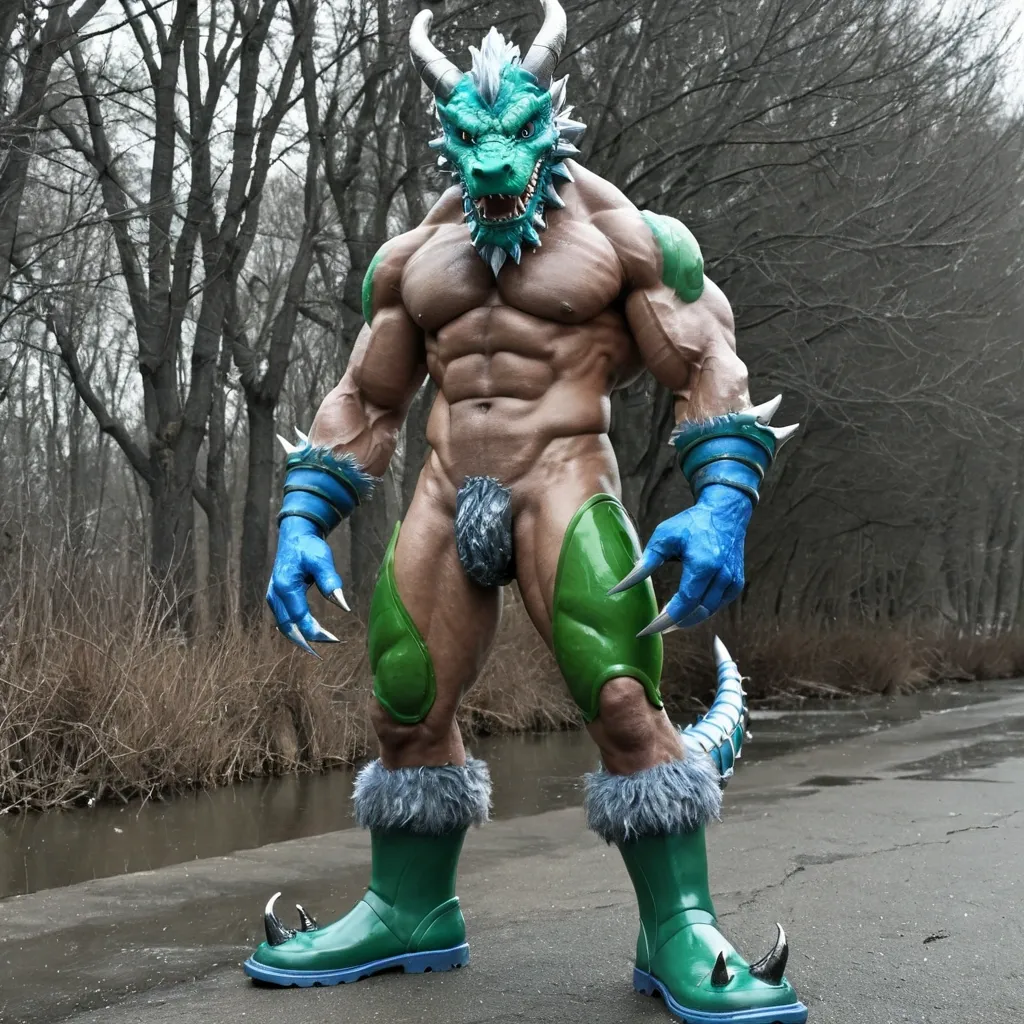Search Results for claw
Explore AI generated designs, images, art and prompts by top community artists and designers.

Edimmu of Sumerian myth. A ghostly , vengeful spirit born from the restless dead. Its form is semi-transparent , wreathed in dark mist and tattered funerary cloths. Hollow , glowing eyes peer from a skeletal , elongated face , and clawed hands reach outward. It drifts above the ground , exuding a chilling aura that seems to warp the air. Its presence evokes fear and sorrow , reflecting its role as a wandering , hungry spirit from ancient Mesopotamian lore. White or transparent background , ultra-detailed , 4k , mythological , spectral , eerie , Sumerian style. ,

A solitary Iron-man fires-up over a cliff edge overlooking a vast , faces a towering beast made of swirling smoke , storm clouds , and burning embers. The creature looms with the vague form of a wolf or bear , its eyes glowing like molten fire and its body alive with crackling veins of orange and red light within the dark gray haze. Its claws are extended , shaped from coiling smoke that curls outward like talons ready to strike. The background is an ethereal void of mist and storm , lit by a diffused , otherworldly light that frames both the sorcerer and the monstrous apparition. The atmosphere feels heavy , as if charged with raw magic and danger , evoking the sensation of a mythic confrontation at the edge of the world. ,

Sky Terror , hybrid dinosaur-bird creature , crow-sized raptor , massive hooked beak with razor-sharp edges and rows of small serrated backward-curving teeth like miniature shark teeth , terror bird crushing power in compact form , Archaeopteryx-style feathered wings with three prominent curved black talons extending from wing joints , claws gleaming like obsidian blades , wing membranes showing both primitive and modern feather structure , powerful muscular legs like secretarybird , sleek aerodynamic build , prehistoric feather patterns , predatory amber eyes , perched on rocky outcrop , dramatic lighting , photorealistic , detailed feather textures , 8K resolution ,
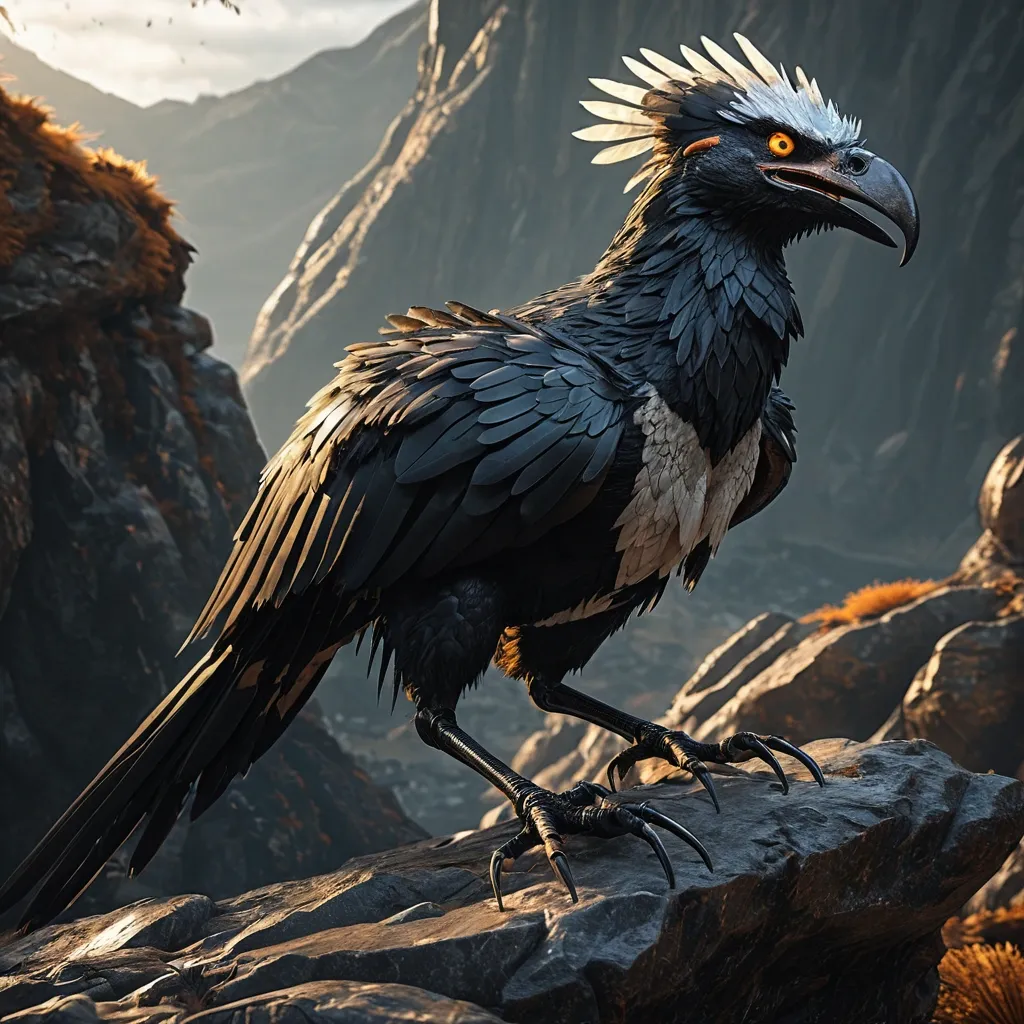
Sky Terror , hybrid dinosaur-bird creature , crow-sized raptor , razor-sharp hooked beak with small backward-curving teeth , Archaeopteryx-style feathered wings with visible claws , powerful muscular legs like secretarybird , sleek aerodynamic build , prehistoric feather patterns , predatory amber eyes , perched on rocky outcrop , dramatic lighting , photorealistic , detailed feather textures , 8K resolution ,
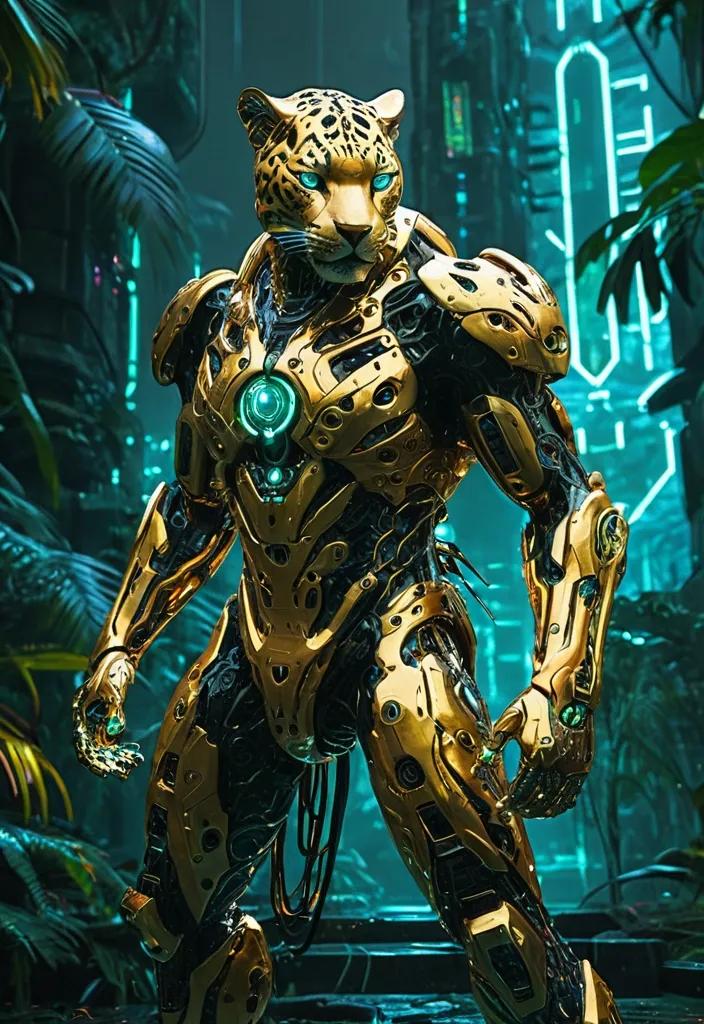
Create a hyper-realistic 8K image of a powerful cybernetic jaguar in a futuristic jungle. Its body should be a seamless fusion of organic strength and biomechanical plating , featuring sleek armor with intricate textures and battle-worn engravings. Its golden fur should retain its iconic rosettes , but interwoven with faint energy circuits that pulse in deep neon hues. Its piercing eyes should radiate intense intelligence , glowing with an advanced AI-driven awareness. Its claws should be reinforced with nanotech titanium , capable of tearing through reinforced steel with surgical precision. The backdrop should depict a dense , neon-infused jungle where mist swirls around ancient cyber ruins , illuminated by holographic glyphs. A professional camera blur effect should add depth , making the jaguar appear even more mysterious and dominant in its domain. ,

A majestic and mysterious hybrid creature , a fusion of a massive tiger and a dragon , perched on a rugged cliff at dusk. The creature's body is covered in striped fur , transitioning into smoky , ethereal feathers along its back and wings. Its eyes glow with a molten red intensity , and its claws are adorned with intricate scales. The rocky ledge is shrouded in mist , with embers floating in the air , adding an eerie glow to the scene. The hyperrealistic style captures every detail , from the texture of the fur and feathers to the ruggedness of the cliff. Cinematic lighting enhances the dramatic atmosphere , casting long shadows and highlighting the creature's powerful presence. The background features a vast , misty landscape , with the fading light of dusk creating a sense of mystery and awe. ,
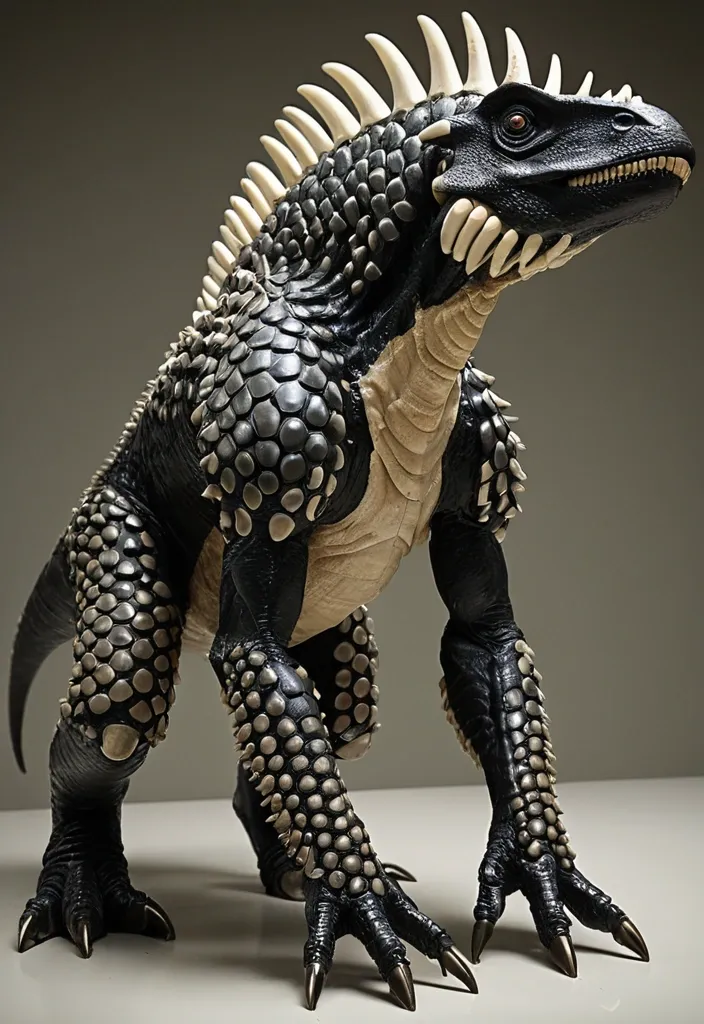
Physical Characteristics: Venenosus Regina is a titanic hybrid dinosaur standing approximately 20 feet tall at the shoulders and stretching 40 feet in length. Its frame is a powerful fusion of Tyrannosaurus rex and Giganotosaurus bulk , with a head shape that blends the robust cranial features of Giganotosaurus and the bony crown of Triceratops. The jawline is adorned with formidable bony spikes on each side , reminiscent of Triceratops horns , enhancing both offense and defense. Its body is armored with large , jet-black , glossy keratin scales inherited from Giant Pangolin DNA , interspersed with cream-colored underbelly patches. These scales are embedded with chromatophore cells from cuttlefish DNA , allowing Venenosus Regina to rapidly alter its skin color , texture , and pattern for camouflage or intimidation. The overall silhouette is muscular , lean and agile , with reduced hind legs that enable knuckle-walking , a trait borrowed from chimpanzee DNA , granting it a unique locomotion style that balances speed and stability.The forelimbs are robust and highly dexterous , equipped with slashing hook claws inspired by Saurophaganax and chimpanzee genetics , capable of delivering devastating swipes and manipulating tools or prey with precision. ,

Physical Characteristics: Venenosus Regina is a titanic hybrid dinosaur standing approximately 20 feet tall at the shoulders and stretching 40 feet in length. Its frame is a powerful fusion of Tyrannosaurus rex and Giganotosaurus bulk , with a head shape that blends the robust cranial features of Giganotosaurus and the bony crown of Triceratops. The jawline is adorned with formidable bony spikes on each side , reminiscent of Triceratops horns , enhancing both offense and defense. Its body is armored with large , jet-black , glossy keratin scales inherited from Giant Pangolin DNA , interspersed with cream-colored underbelly patches. These scales are embedded with chromatophore cells from cuttlefish DNA , allowing Venenosus Regina to rapidly alter its skin color , texture , and pattern for camouflage or intimidation. The overall silhouette is muscular , lean and agile , with reduced hind legs that enable knuckle-walking , a trait borrowed from chimpanzee DNA , granting it a unique locomotion style that balances speed and stability.The forelimbs are robust and highly dexterous , equipped with slashing hook claws inspired by Saurophaganax and chimpanzee genetics , capable of delivering devastating swipes and manipulating tools or prey with precision. ,
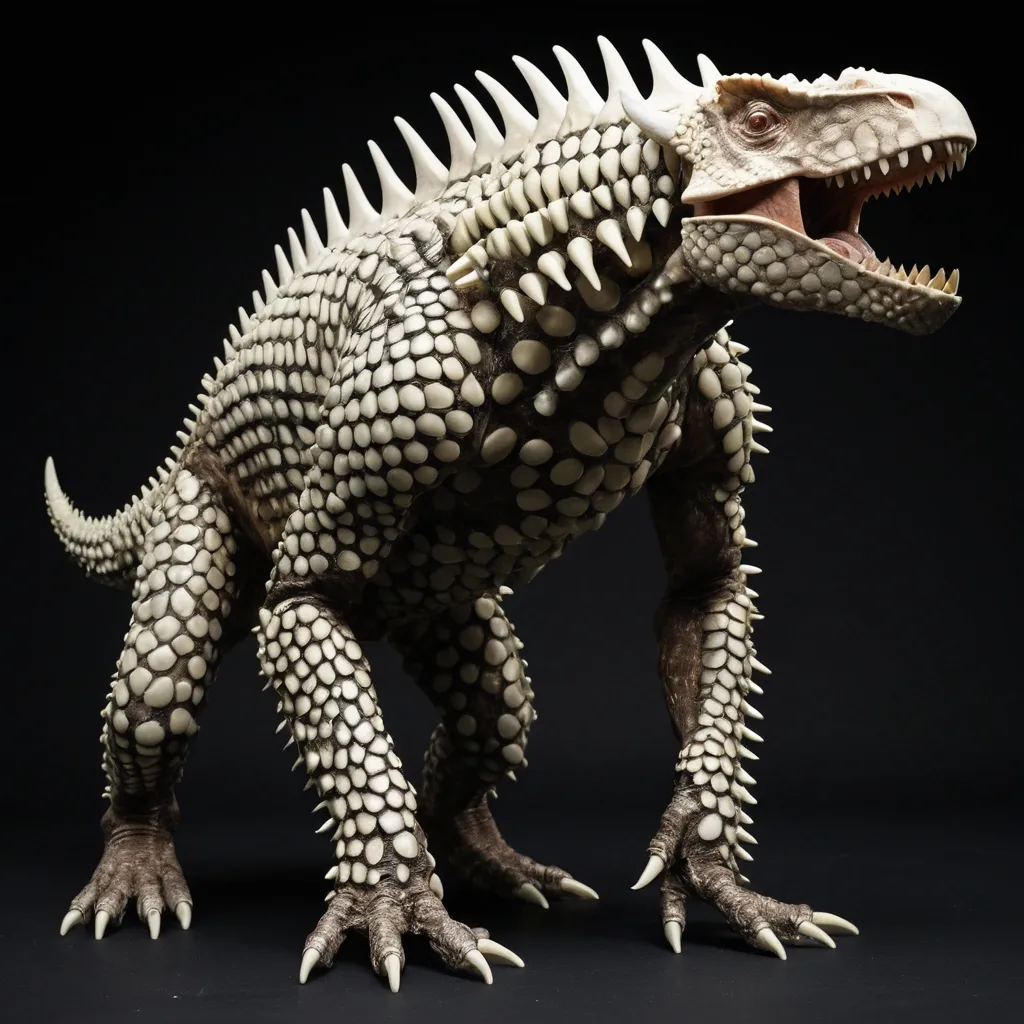
Physical Characteristics: Venenosus Regina is a titanic hybrid dinosaur standing approximately 20 feet tall at the shoulders and stretching 40 feet in length. Its frame is a powerful fusion of Tyrannosaurus rex and Giganotosaurus bulk , with a head shape that blends the robust cranial features of Giganotosaurus and the bony crown of Triceratops. The jawline is adorned with formidable bony spikes on each side , reminiscent of Triceratops horns , enhancing both offense and defense. Its body is armored with large , jet-black , glossy keratin scales inherited from Giant Pangolin DNA , interspersed with cream-colored underbelly patches. These scales are embedded with chromatophore cells from cuttlefish DNA , allowing Venenosus Regina to rapidly alter its skin color , texture , and pattern for camouflage or intimidation. The overall silhouette is muscular , lean and agile , with reduced hind legs that enable knuckle-walking , a trait borrowed from chimpanzee DNA , granting it a unique locomotion style that balances speed and stability.The forelimbs are robust and highly dexterous , equipped with slashing hook claws inspired by Saurophaganax and chimpanzee genetics , capable of delivering devastating swipes and manipulating tools or prey with precision. ,
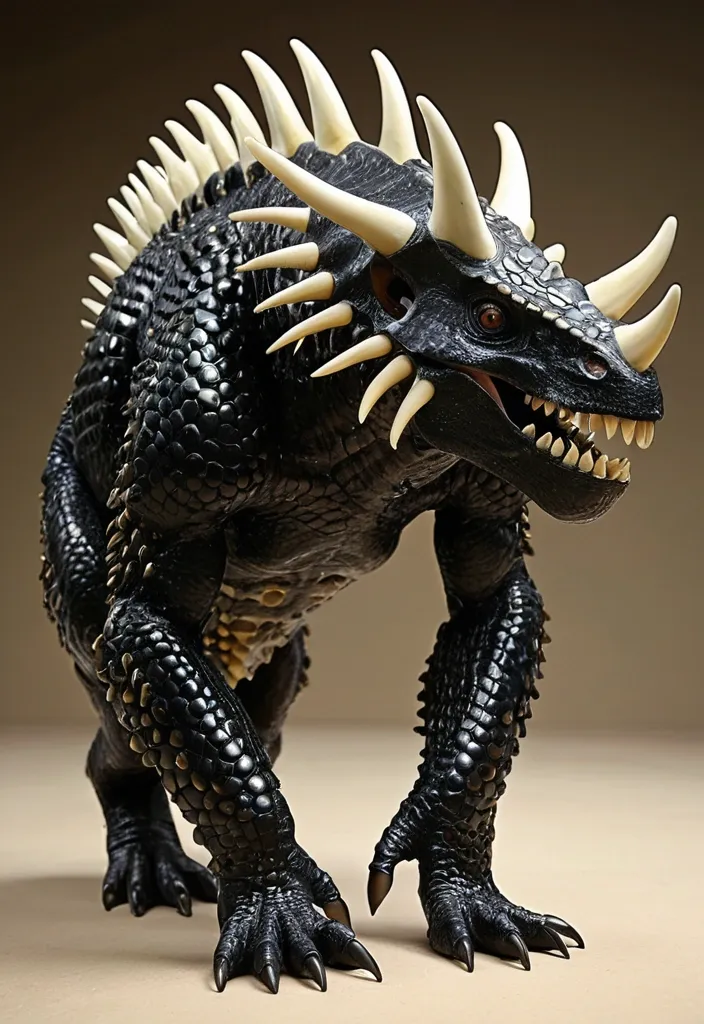
Physical Characteristics: Venenosus Regina is a titanic hybrid dinosaur standing approximately 20 feet tall at the shoulders and stretching 40 feet in length. Its frame is a powerful fusion of Tyrannosaurus rex and Giganotosaurus bulk , with a head shape that blends the robust cranial features of Giganotosaurus and the bony crown of Triceratops. The jawline is adorned with formidable bony spikes on each side , reminiscent of Triceratops horns , enhancing both offense and defense. Its body is armored with large , jet-black , glossy keratin scales inherited from Giant Pangolin DNA , interspersed with cream-colored underbelly patches. These scales are embedded with chromatophore cells from cuttlefish DNA , allowing Venenosus Regina to rapidly alter its skin color , texture , and pattern for camouflage or intimidation. The overall silhouette is muscular , lean and agile , with reduced hind legs that enable knuckle-walking , a trait borrowed from chimpanzee DNA , granting it a unique locomotion style that balances speed and stability.The forelimbs are robust and highly dexterous , equipped with slashing hook claws inspired by Saurophaganax and chimpanzee genetics , capable of delivering devastating swipes and manipulating tools or prey with precision. ,
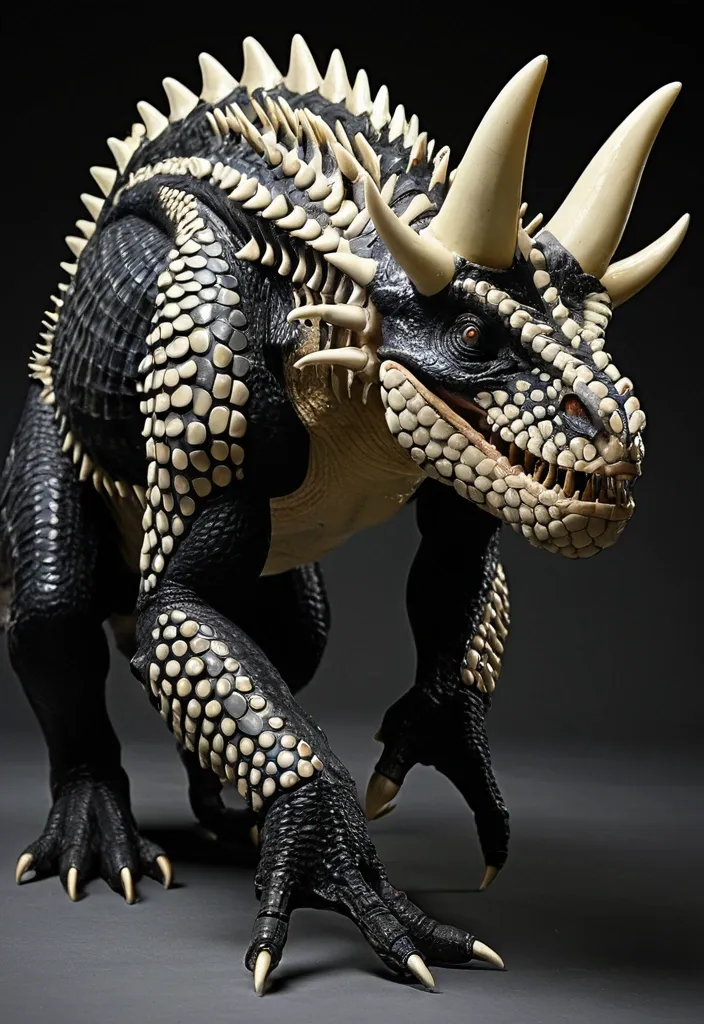
Physical Characteristics: Venenosus Regina is a titanic hybrid dinosaur standing approximately 20 feet tall at the shoulders and stretching 40 feet in length. Its frame is a powerful fusion of Tyrannosaurus rex and Giganotosaurus bulk , with a head shape that blends the robust cranial features of Giganotosaurus and the bony crown of Triceratops. The jawline is adorned with formidable bony spikes on each side , reminiscent of Triceratops horns , enhancing both offense and defense. Its body is armored with large , jet-black , glossy keratin scales inherited from Giant Pangolin DNA , interspersed with cream-colored underbelly patches. These scales are embedded with chromatophore cells from cuttlefish DNA , allowing Venenosus Regina to rapidly alter its skin color , texture , and pattern for camouflage or intimidation. The overall silhouette is muscular , lean and agile , with reduced hind legs that enable knuckle-walking , a trait borrowed from chimpanzee DNA , granting it a unique locomotion style that balances speed and stability.The forelimbs are robust and highly dexterous , equipped with slashing hook claws inspired by Saurophaganax and chimpanzee genetics , capable of delivering devastating swipes and manipulating tools or prey with precision. ,
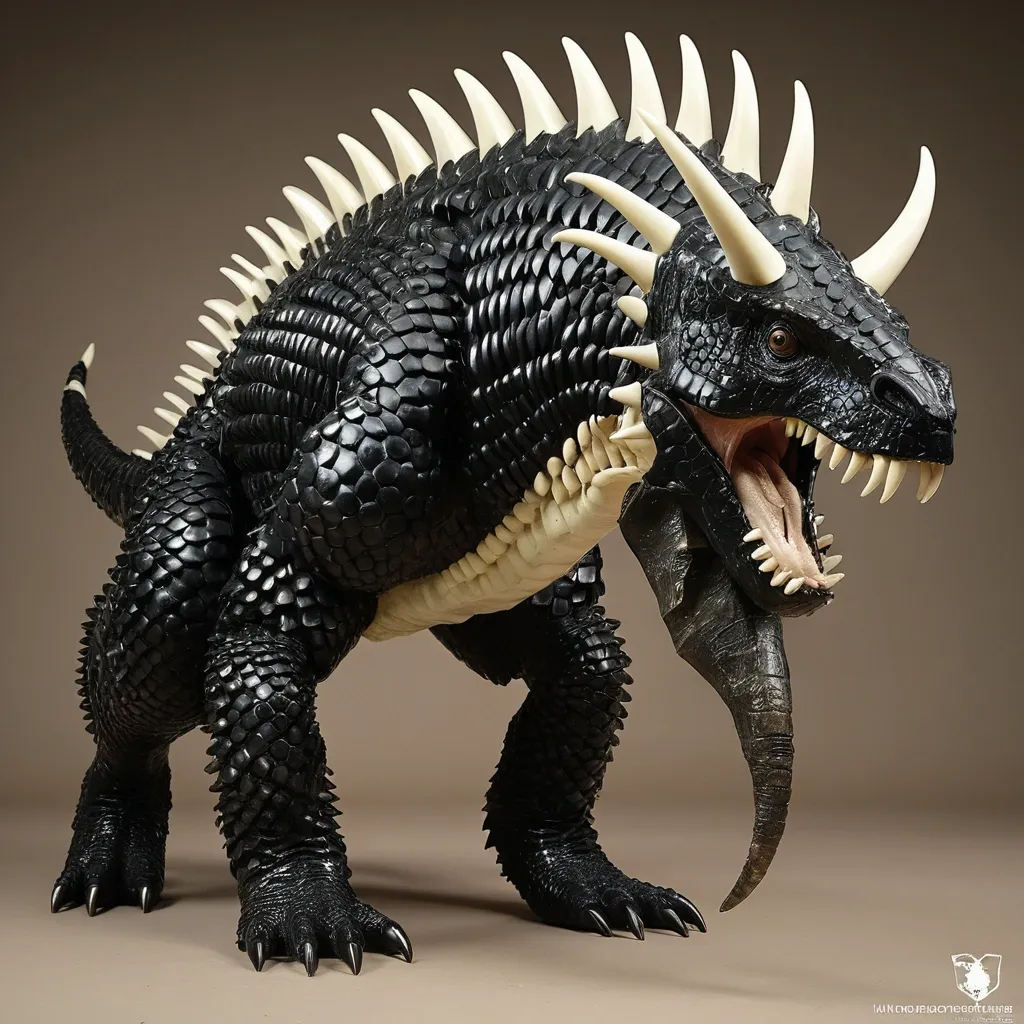
Physical Characteristics: Venenosus Regina is a titanic hybrid dinosaur standing approximately 20 feet tall at the shoulders and stretching 40 feet in length. Its frame is a powerful fusion of Tyrannosaurus rex and Giganotosaurus bulk , with a head shape that blends the robust cranial features of Giganotosaurus and the bony crown of Triceratops. The jawline is adorned with formidable bony spikes on each side , reminiscent of Triceratops horns , enhancing both offense and defense. Its body is armored with large , jet-black , glossy keratin scales inherited from Giant Pangolin DNA , interspersed with cream-colored underbelly patches. These scales are embedded with chromatophore cells from cuttlefish DNA , allowing Venenosus Regina to rapidly alter its skin color , texture , and pattern for camouflage or intimidation. The overall silhouette is muscular , lean and agile , with reduced hind legs that enable knuckle-walking , a trait borrowed from chimpanzee DNA , granting it a unique locomotion style that balances speed and stability.The forelimbs are robust and highly dexterous , equipped with slashing hook claws inspired by Saurophaganax and chimpanzee genetics , capable of delivering devastating swipes and manipulating tools or prey with precision. ,
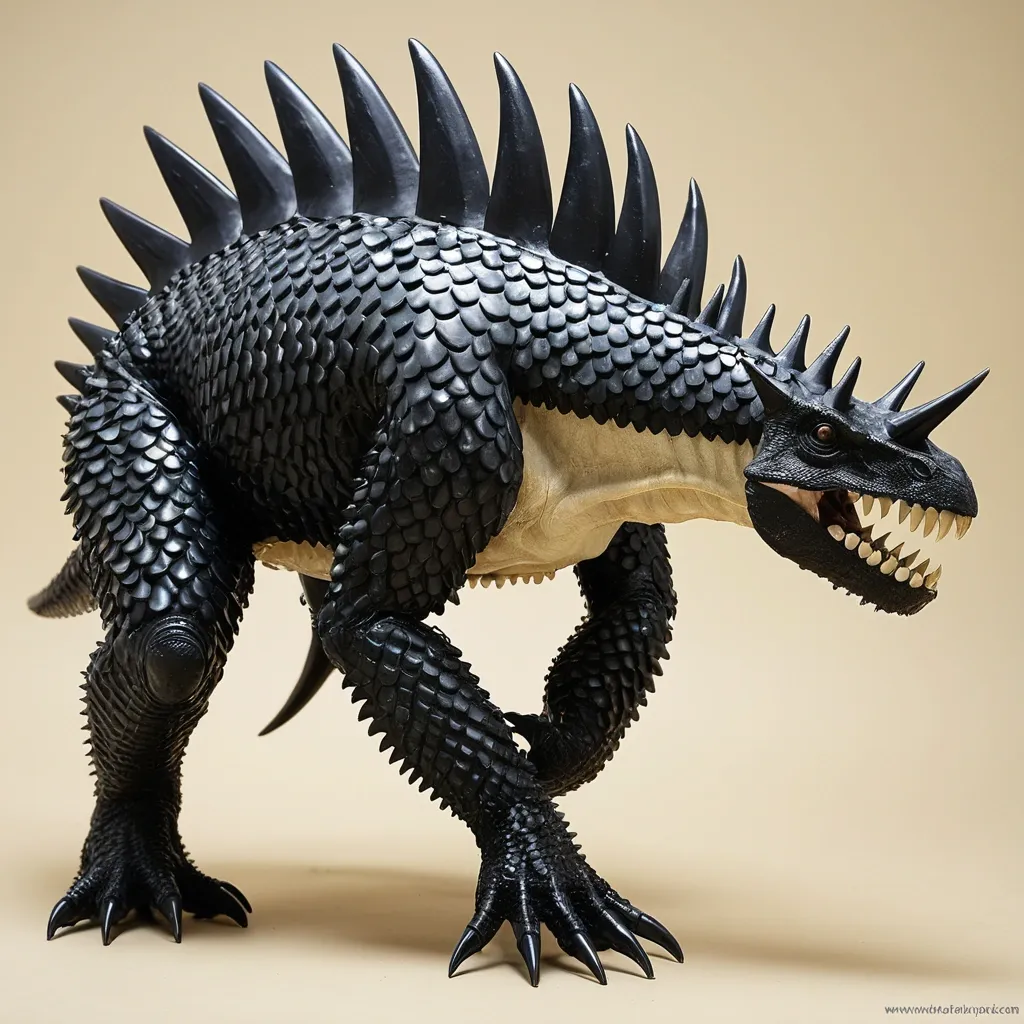
Physical Characteristics: Venenosus Regina is a titanic hybrid dinosaur standing approximately 20 feet tall at the shoulders and stretching 40 feet in length. Its frame is a powerful fusion of Tyrannosaurus rex and Giganotosaurus bulk , with a head shape that blends the robust cranial features of Giganotosaurus and the bony crown of Triceratops. The jawline is adorned with formidable bony spikes on each side , reminiscent of Triceratops horns , enhancing both offense and defense. Its body is armored with large , jet-black , glossy keratin scales inherited from Giant Pangolin DNA , interspersed with cream-colored underbelly patches. These scales are embedded with chromatophore cells from cuttlefish DNA , allowing Venenosus Regina to rapidly alter its skin color , texture , and pattern for camouflage or intimidation. The overall silhouette is muscular , lean and agile , with reduced hind legs that enable knuckle-walking , a trait borrowed from chimpanzee DNA , granting it a unique locomotion style that balances speed and stability.The forelimbs are robust and highly dexterous , equipped with slashing hook claws inspired by Saurophaganax and chimpanzee genetics , capable of delivering devastating swipes and manipulating tools or prey with precision. ,
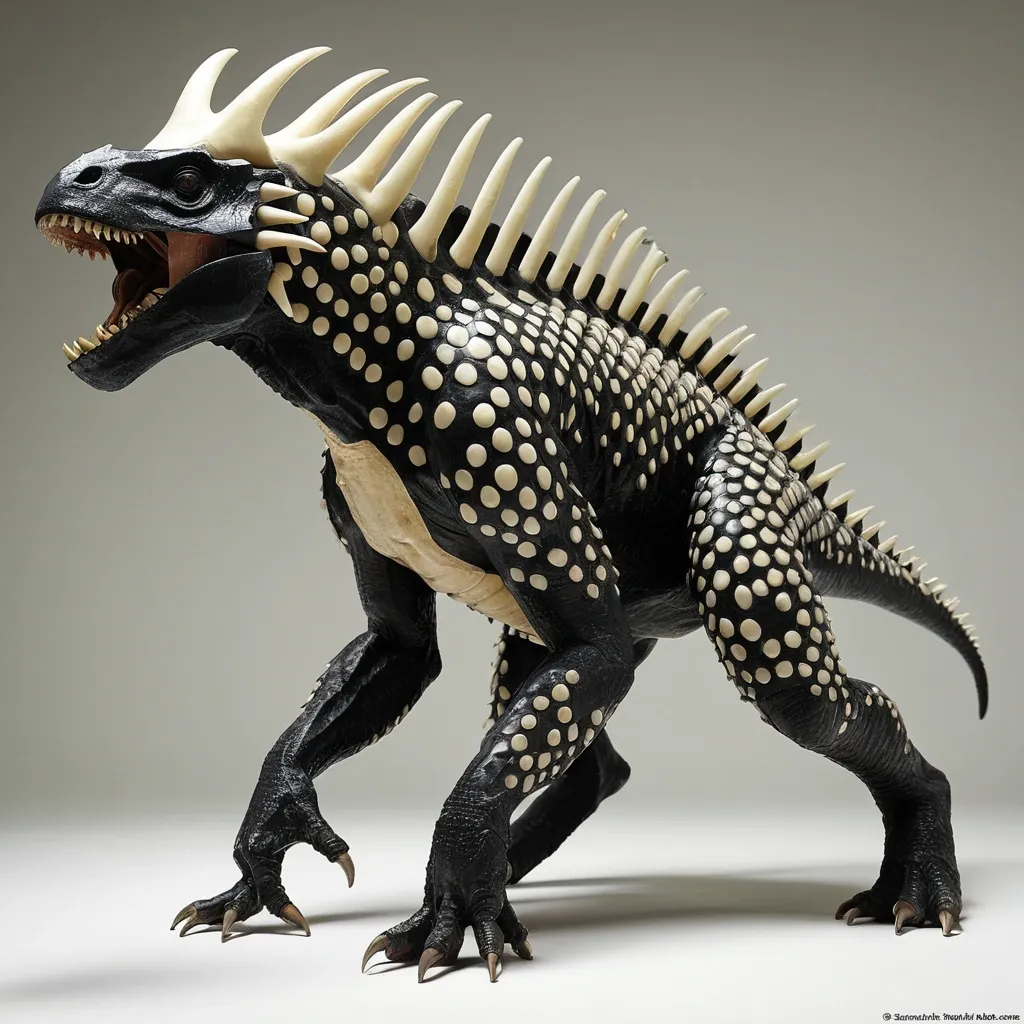
Physical Characteristics: Venenosus Regina is a titanic hybrid dinosaur standing approximately 20 feet tall at the shoulders and stretching 40 feet in length. Its frame is a powerful fusion of Tyrannosaurus rex and Giganotosaurus bulk , with a head shape that blends the robust cranial features of Giganotosaurus and the bony crown of Triceratops. The jawline is adorned with formidable bony spikes on each side , reminiscent of Triceratops horns , enhancing both offense and defense. Its body is armored with large , jet-black , glossy keratin scales inherited from Giant Pangolin DNA , interspersed with cream-colored underbelly patches. These scales are embedded with chromatophore cells from cuttlefish DNA , allowing Venenosus Regina to rapidly alter its skin color , texture , and pattern for camouflage or intimidation. The overall silhouette is muscular , lean and agile , with reduced hind legs that enable knuckle-walking , a trait borrowed from chimpanzee DNA , granting it a unique locomotion style that balances speed and stability.The forelimbs are robust and highly dexterous , equipped with slashing hook claws inspired by Saurophaganax and chimpanzee genetics , capable of delivering devastating swipes and manipulating tools or prey with precision. ,
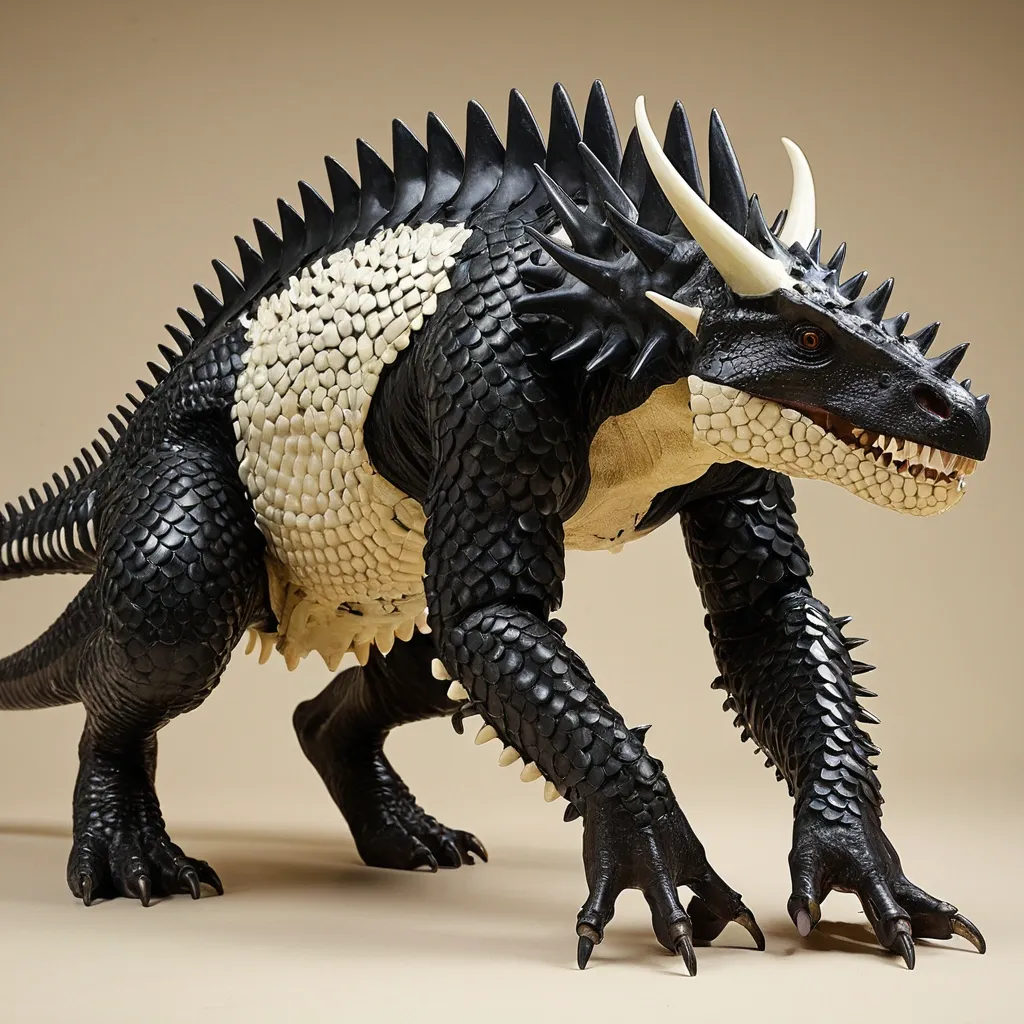
Physical Characteristics: Venenosus Regina is a titanic hybrid dinosaur standing approximately 20 feet tall at the shoulders and stretching 40 feet in length. Its frame is a powerful fusion of Tyrannosaurus rex and Giganotosaurus bulk , with a head shape that blends the robust cranial features of Giganotosaurus and the bony crown of Triceratops. The jawline is adorned with formidable bony spikes on each side , reminiscent of Triceratops horns , enhancing both offense and defense. Its body is armored with large , jet-black , glossy keratin scales inherited from Giant Pangolin DNA , interspersed with cream-colored underbelly patches. These scales are embedded with chromatophore cells from cuttlefish DNA , allowing Venenosus Regina to rapidly alter its skin color , texture , and pattern for camouflage or intimidation. The overall silhouette is muscular , lean and agile , with reduced hind legs that enable knuckle-walking , a trait borrowed from chimpanzee DNA , granting it a unique locomotion style that balances speed and stability.The forelimbs are robust and highly dexterous , equipped with slashing hook claws inspired by Saurophaganax and chimpanzee genetics , capable of delivering devastating swipes and manipulating tools or prey with precision. ,
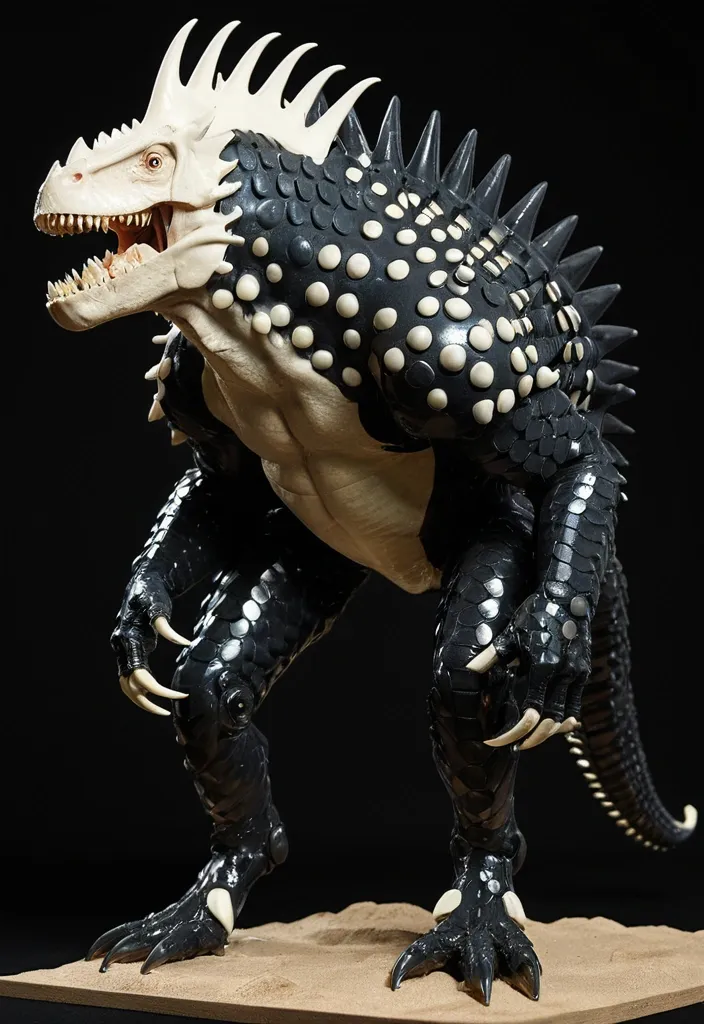
Physical Characteristics: Venenosus Regina is a titanic hybrid dinosaur standing approximately 20 feet tall at the shoulders and stretching 40 feet in length. Its frame is a powerful fusion of Tyrannosaurus rex and Giganotosaurus bulk , with a head shape that blends the robust cranial features of Giganotosaurus and the bony crown of Triceratops. The jawline is adorned with formidable bony spikes on each side , reminiscent of Triceratops horns , enhancing both offense and defense. Its body is armored with large , jet-black , glossy keratin scales inherited from Giant Pangolin DNA , interspersed with cream-colored underbelly patches. These scales are embedded with chromatophore cells from cuttlefish DNA , allowing Venenosus Regina to rapidly alter its skin color , texture , and pattern for camouflage or intimidation. The overall silhouette is muscular , lean and agile , with reduced hind legs that enable knuckle-walking , a trait borrowed from chimpanzee DNA , granting it a unique locomotion style that balances speed and stability.The forelimbs are robust and highly dexterous , equipped with slashing hook claws inspired by Saurophaganax and chimpanzee genetics , capable of delivering devastating swipes and manipulating tools or prey with precision. ,
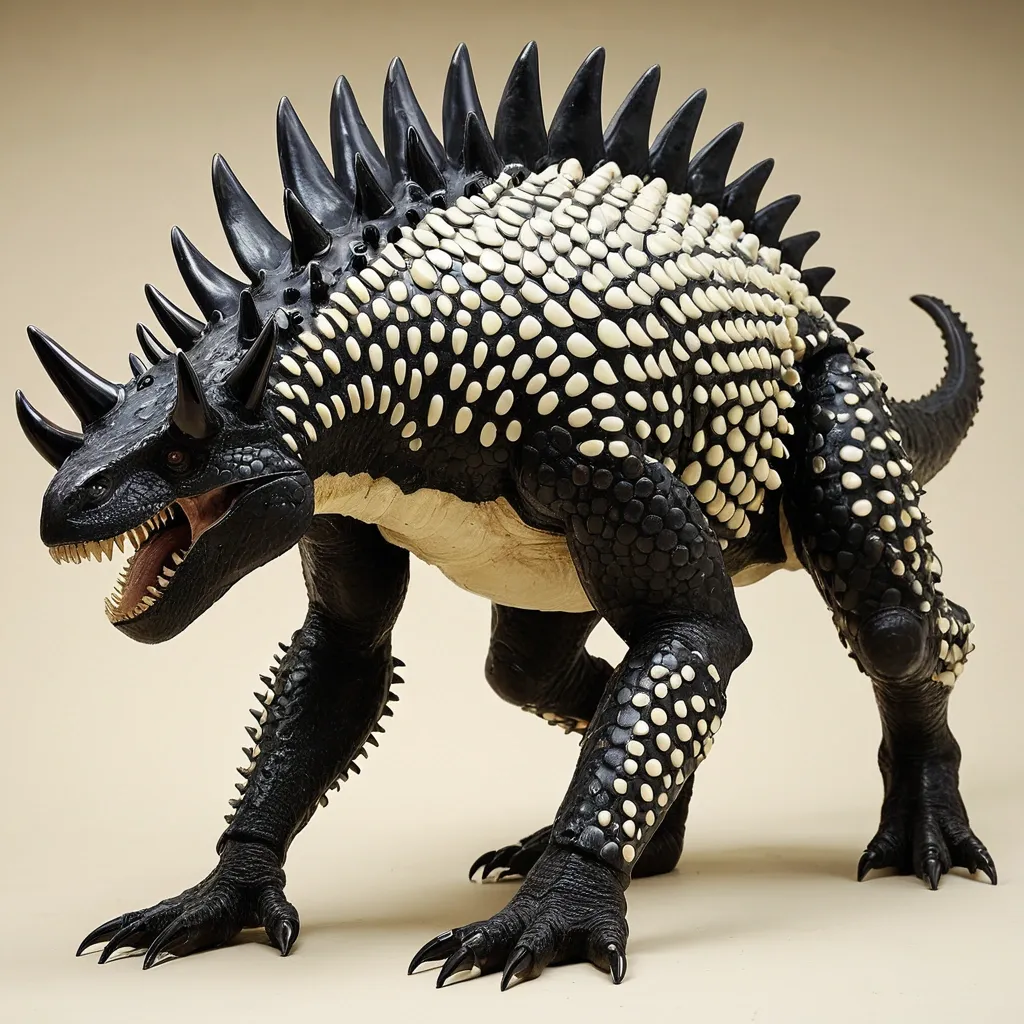
Physical Characteristics: Venenosus Regina is a titanic hybrid dinosaur standing approximately 20 feet tall at the shoulders and stretching 40 feet in length. Its frame is a powerful fusion of Tyrannosaurus rex and Giganotosaurus bulk , with a head shape that blends the robust cranial features of Giganotosaurus and the bony crown of Triceratops. The jawline is adorned with formidable bony spikes on each side , reminiscent of Triceratops horns , enhancing both offense and defense. Its body is armored with large , jet-black , glossy keratin scales inherited from Giant Pangolin DNA , interspersed with cream-colored underbelly patches. These scales are embedded with chromatophore cells from cuttlefish DNA , allowing Venenosus Regina to rapidly alter its skin color , texture , and pattern for camouflage or intimidation. The overall silhouette is muscular , lean and agile , with reduced hind legs that enable knuckle-walking , a trait borrowed from chimpanzee DNA , granting it a unique locomotion style that balances speed and stability.The forelimbs are robust and highly dexterous , equipped with slashing hook claws inspired by Saurophaganax and chimpanzee genetics , capable of delivering devastating swipes and manipulating tools or prey with precision. ,
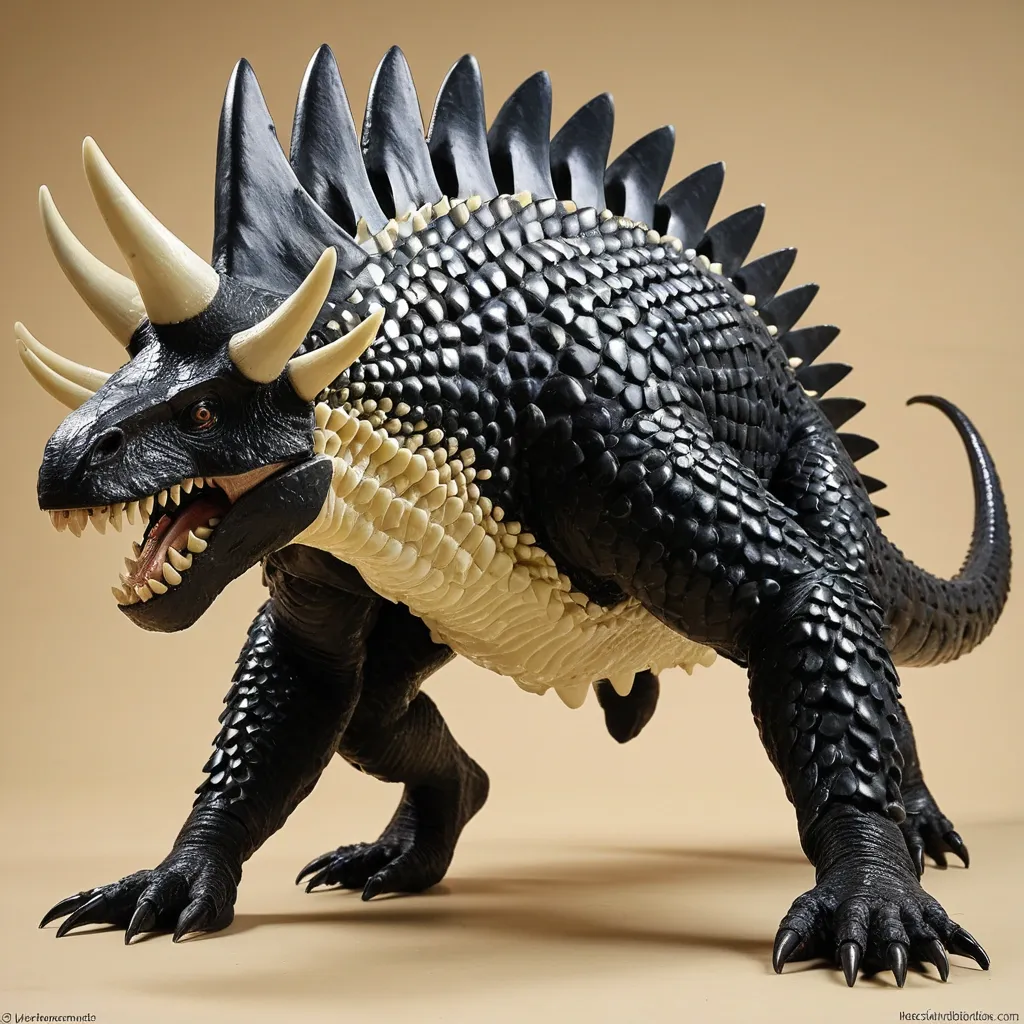
Physical Characteristics: Venenosus Regina is a titanic hybrid dinosaur standing approximately 20 feet tall at the shoulders and stretching 40 feet in length. Its frame is a powerful fusion of Tyrannosaurus rex and Giganotosaurus bulk , with a head shape that blends the robust cranial features of Giganotosaurus and the bony crown of Triceratops. The jawline is adorned with formidable bony spikes on each side , reminiscent of Triceratops horns , enhancing both offense and defense. Its body is armored with large , jet-black , glossy keratin scales inherited from Giant Pangolin DNA , interspersed with cream-colored underbelly patches. These scales are embedded with chromatophore cells from cuttlefish DNA , allowing Venenosus Regina to rapidly alter its skin color , texture , and pattern for camouflage or intimidation. The overall silhouette is muscular , lean and agile , with reduced hind legs that enable knuckle-walking , a trait borrowed from chimpanzee DNA , granting it a unique locomotion style that balances speed and stability.The forelimbs are robust and highly dexterous , equipped with slashing hook claws inspired by Saurophaganax and chimpanzee genetics , capable of delivering devastating swipes and manipulating tools or prey with precision. ,
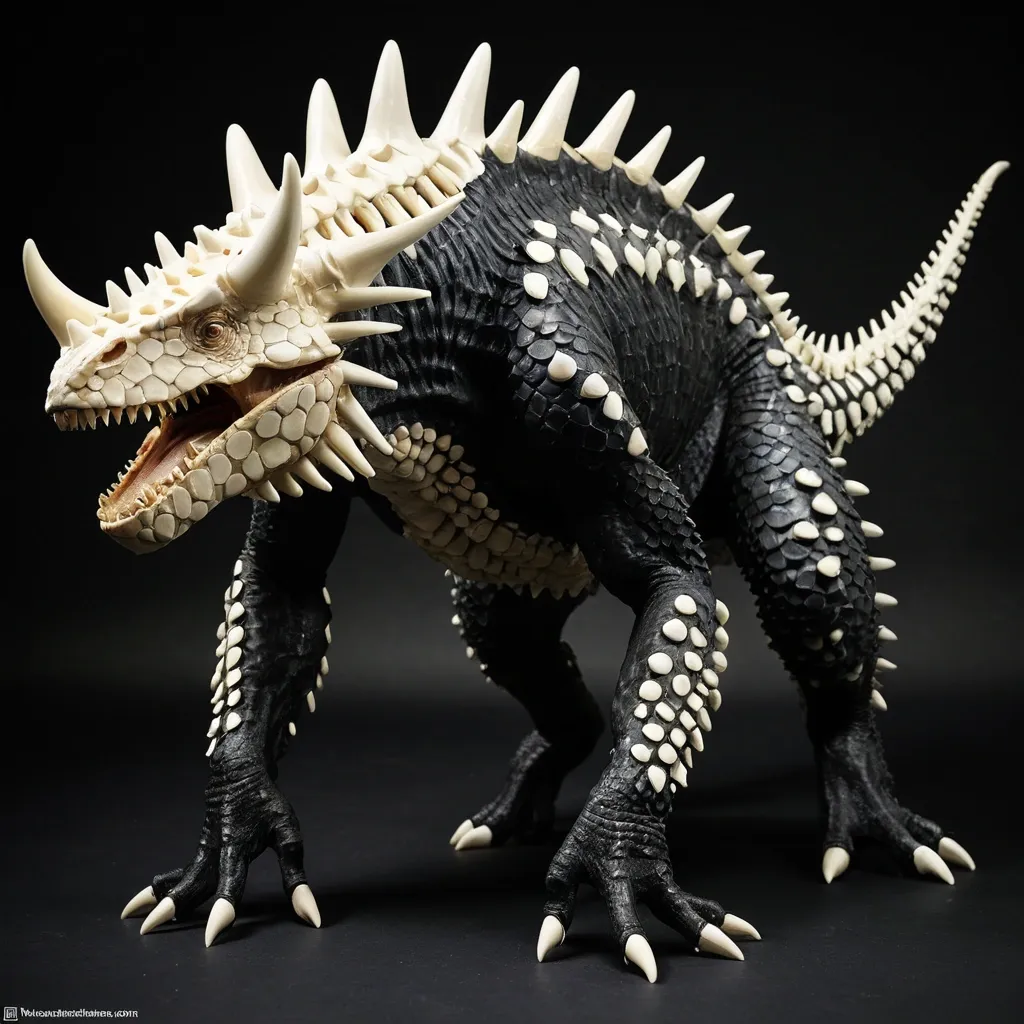
Physical Characteristics: Venenosus Regina is a titanic hybrid dinosaur standing approximately 20 feet tall at the shoulders and stretching 40 feet in length. Its frame is a powerful fusion of Tyrannosaurus rex and Giganotosaurus bulk , with a head shape that blends the robust cranial features of Giganotosaurus and the bony crown of Triceratops. The jawline is adorned with formidable bony spikes on each side , reminiscent of Triceratops horns , enhancing both offense and defense. Its body is armored with large , jet-black , glossy keratin scales inherited from Giant Pangolin DNA , interspersed with cream-colored underbelly patches. These scales are embedded with chromatophore cells from cuttlefish DNA , allowing Venenosus Regina to rapidly alter its skin color , texture , and pattern for camouflage or intimidation. The overall silhouette is muscular , lean and agile , with reduced hind legs that enable knuckle-walking , a trait borrowed from chimpanzee DNA , granting it a unique locomotion style that balances speed and stability.The forelimbs are robust and highly dexterous , equipped with slashing hook claws inspired by Saurophaganax and chimpanzee genetics , capable of delivering devastating swipes and manipulating tools or prey with precision. ,
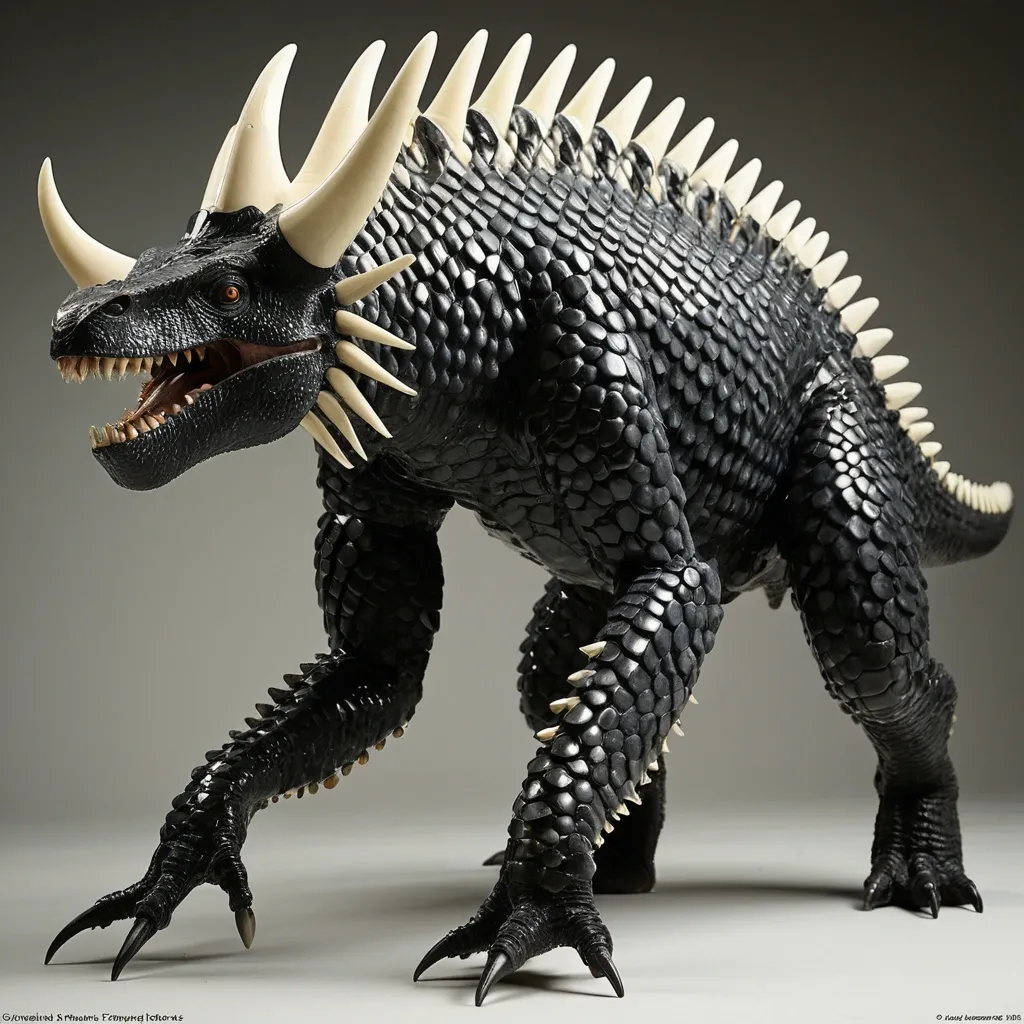
Physical Characteristics: Venenosus Regina is a titanic hybrid dinosaur standing approximately 20 feet tall at the shoulders and stretching 40 feet in length. Its frame is a powerful fusion of Tyrannosaurus rex and Giganotosaurus bulk , with a head shape that blends the robust cranial features of Giganotosaurus and the bony crown of Triceratops. The jawline is adorned with formidable bony spikes on each side , reminiscent of Triceratops horns , enhancing both offense and defense. Its body is armored with large , jet-black , glossy keratin scales inherited from Giant Pangolin DNA , interspersed with cream-colored underbelly patches. These scales are embedded with chromatophore cells from cuttlefish DNA , allowing Venenosus Regina to rapidly alter its skin color , texture , and pattern for camouflage or intimidation. The overall silhouette is muscular , lean and agile , with reduced hind legs that enable knuckle-walking , a trait borrowed from chimpanzee DNA , granting it a unique locomotion style that balances speed and stability.The forelimbs are robust and highly dexterous , equipped with slashing hook claws inspired by Saurophaganax and chimpanzee genetics , capable of delivering devastating swipes and manipulating tools or prey with precision. ,
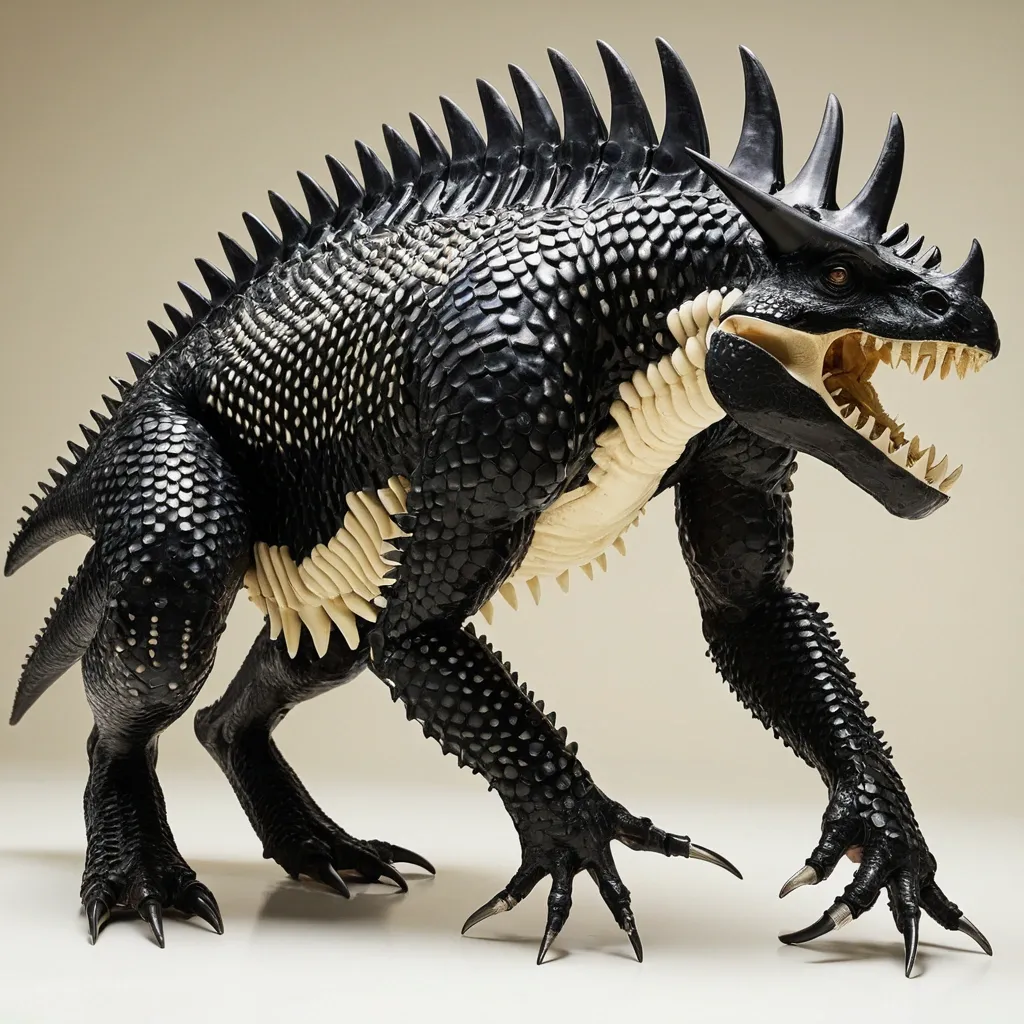
Physical Characteristics: Venenosus Regina is a titanic hybrid dinosaur standing approximately 20 feet tall at the shoulders and stretching 40 feet in length. Its frame is a powerful fusion of Tyrannosaurus rex and Giganotosaurus bulk , with a head shape that blends the robust cranial features of Giganotosaurus and the bony crown of Triceratops. The jawline is adorned with formidable bony spikes on each side , reminiscent of Triceratops horns , enhancing both offense and defense. Its body is armored with large , jet-black , glossy keratin scales inherited from Giant Pangolin DNA , interspersed with cream-colored underbelly patches. These scales are embedded with chromatophore cells from cuttlefish DNA , allowing Venenosus Regina to rapidly alter its skin color , texture , and pattern for camouflage or intimidation. The overall silhouette is muscular , lean and agile , with reduced hind legs that enable knuckle-walking , a trait borrowed from chimpanzee DNA , granting it a unique locomotion style that balances speed and stability.The forelimbs are robust and highly dexterous , equipped with slashing hook claws inspired by Saurophaganax and chimpanzee genetics , capable of delivering devastating swipes and manipulating tools or prey with precision. ,
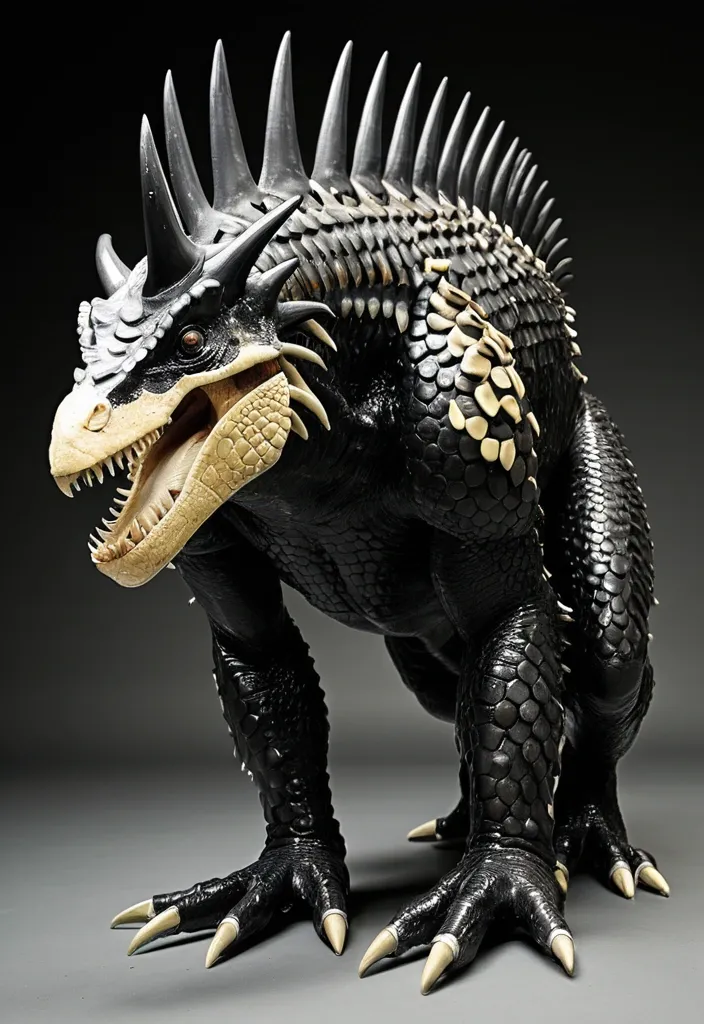
Physical Characteristics: Venenosus Regina is a titanic hybrid dinosaur standing approximately 20 feet tall at the shoulders and stretching 40 feet in length. Its frame is a powerful fusion of Tyrannosaurus rex and Giganotosaurus bulk , with a head shape that blends the robust cranial features of Giganotosaurus and the bony crown of Triceratops. The jawline is adorned with formidable bony spikes on each side , reminiscent of Triceratops horns , enhancing both offense and defense. Its body is armored with large , jet-black , glossy keratin scales inherited from Giant Pangolin DNA , interspersed with cream-colored underbelly patches. These scales are embedded with chromatophore cells from cuttlefish DNA , allowing Venenosus Regina to rapidly alter its skin color , texture , and pattern for camouflage or intimidation. The overall silhouette is muscular , lean and agile , with reduced hind legs that enable knuckle-walking , a trait borrowed from chimpanzee DNA , granting it a unique locomotion style that balances speed and stability.The forelimbs are robust and highly dexterous , equipped with slashing hook claws inspired by Saurophaganax and chimpanzee genetics , capable of delivering devastating swipes and manipulating tools or prey with precision. ,

Physical Characteristics: Venenosus Regina is a titanic hybrid dinosaur standing approximately 20 feet tall at the shoulders and stretching 40 feet in length. Its frame is a powerful fusion of Tyrannosaurus rex and Giganotosaurus bulk , with a head shape that blends the robust cranial features of Giganotosaurus and the bony crown of Triceratops. The jawline is adorned with formidable bony spikes on each side , reminiscent of Triceratops horns , enhancing both offense and defense. Its body is armored with large , jet-black , glossy keratin scales inherited from Giant Pangolin DNA , interspersed with cream-colored underbelly patches. These scales are embedded with chromatophore cells from cuttlefish DNA , allowing Venenosus Regina to rapidly alter its skin color , texture , and pattern for camouflage or intimidation. The overall silhouette is muscular , lean and agile , with reduced hind legs that enable knuckle-walking , a trait borrowed from chimpanzee DNA , granting it a unique locomotion style that balances speed and stability.The forelimbs are robust and highly dexterous , equipped with slashing hook claws inspired by Saurophaganax and chimpanzee genetics , capable of delivering devastating swipes and manipulating tools or prey with precision. ,
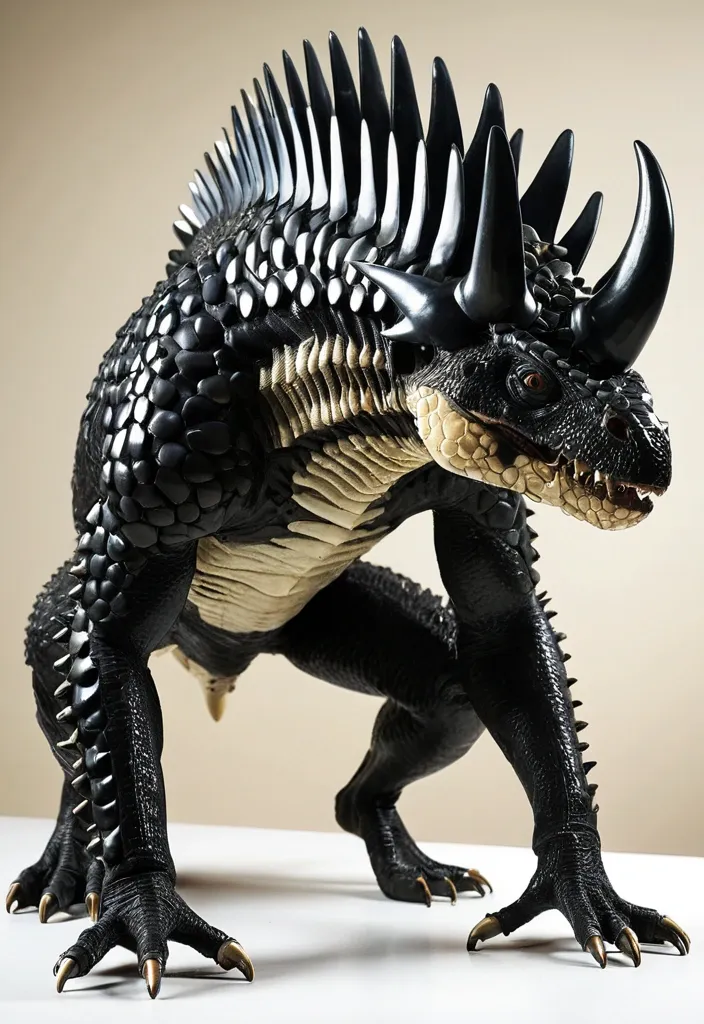
Physical Characteristics: Venenosus Regina is a titanic hybrid dinosaur standing approximately 20 feet tall at the shoulders and stretching 40 feet in length. Its frame is a powerful fusion of Tyrannosaurus rex and Giganotosaurus bulk , with a head shape that blends the robust cranial features of Giganotosaurus and the bony crown of Triceratops. The jawline is adorned with formidable bony spikes on each side , reminiscent of Triceratops horns , enhancing both offense and defense. Its body is armored with large , jet-black , glossy keratin scales inherited from Giant Pangolin DNA , interspersed with cream-colored underbelly patches. These scales are embedded with chromatophore cells from cuttlefish DNA , allowing Venenosus Regina to rapidly alter its skin color , texture , and pattern for camouflage or intimidation. The overall silhouette is muscular , lean and agile , with reduced hind legs that enable knuckle-walking , a trait borrowed from chimpanzee DNA , granting it a unique locomotion style that balances speed and stability.The forelimbs are robust and highly dexterous , equipped with slashing hook claws inspired by Saurophaganax and chimpanzee genetics , capable of delivering devastating swipes and manipulating tools or prey with precision. ,
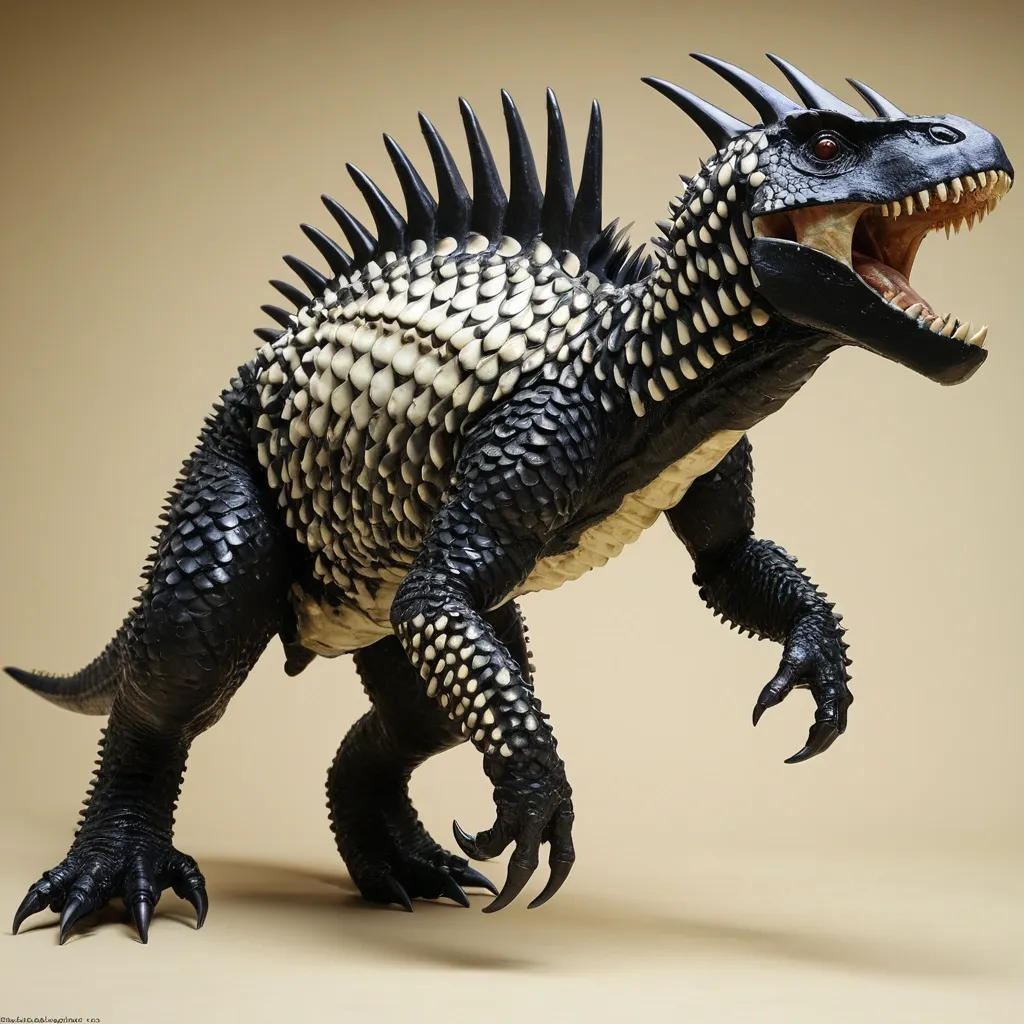
Physical Characteristics: Venenosus Regina is a titanic hybrid dinosaur standing approximately 20 feet tall at the shoulders and stretching 40 feet in length. Its frame is a powerful fusion of Tyrannosaurus rex and Giganotosaurus bulk , with a head shape that blends the robust cranial features of Giganotosaurus and the bony crown of Triceratops. The jawline is adorned with formidable bony spikes on each side , reminiscent of Triceratops horns , enhancing both offense and defense. Its body is armored with large , jet-black , glossy keratin scales inherited from Giant Pangolin DNA , interspersed with cream-colored underbelly patches. These scales are embedded with chromatophore cells from cuttlefish DNA , allowing Venenosus Regina to rapidly alter its skin color , texture , and pattern for camouflage or intimidation. The overall silhouette is muscular , lean and agile , with reduced hind legs that enable knuckle-walking , a trait borrowed from chimpanzee DNA , granting it a unique locomotion style that balances speed and stability.The forelimbs are robust and highly dexterous , equipped with slashing hook claws inspired by Saurophaganax and chimpanzee genetics , capable of delivering devastating swipes and manipulating tools or prey with precision. ,
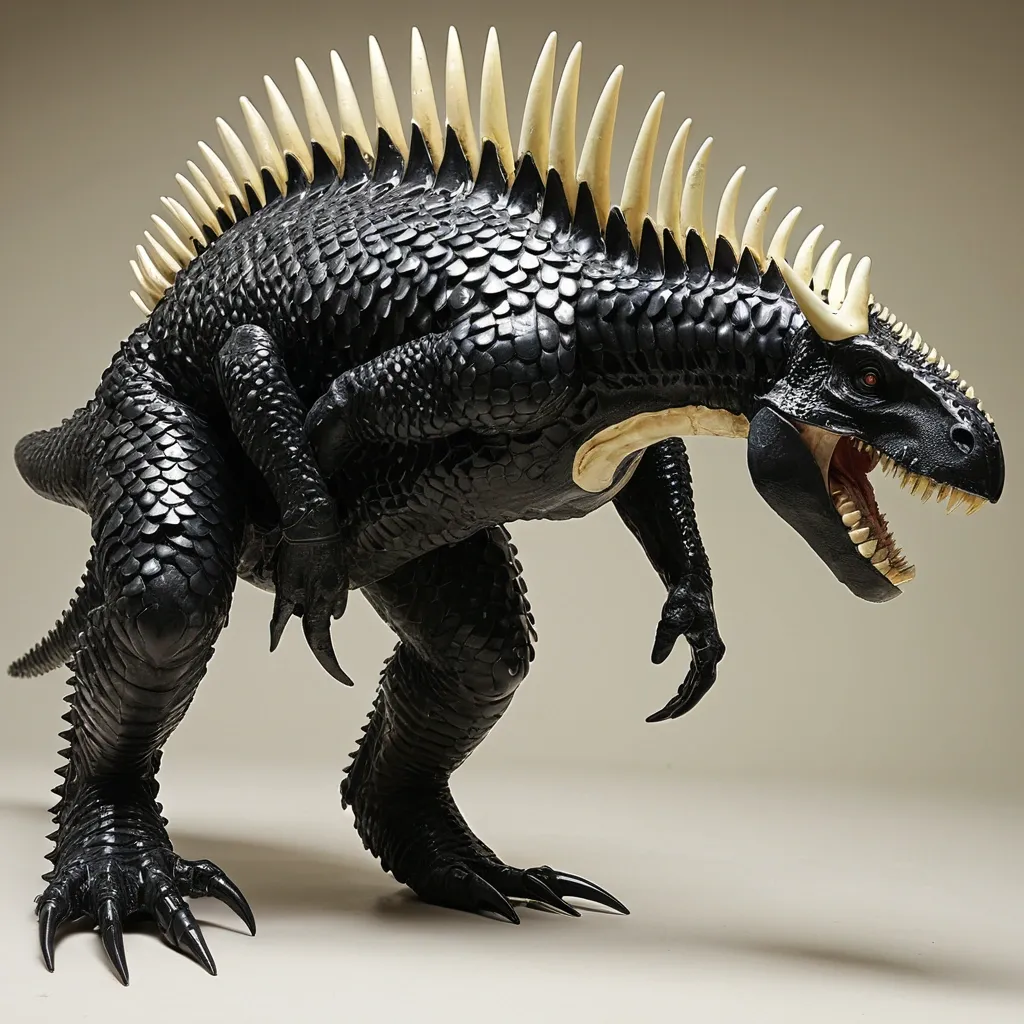
Physical Characteristics: Venenosus Regina is a titanic hybrid dinosaur standing approximately 20 feet tall at the shoulders and stretching 40 feet in length. Its frame is a powerful fusion of Tyrannosaurus rex and Giganotosaurus bulk , with a head shape that blends the robust cranial features of Giganotosaurus and the bony crown of Triceratops. The jawline is adorned with formidable bony spikes on each side , reminiscent of Triceratops horns , enhancing both offense and defense. Its body is armored with large , jet-black , glossy keratin scales inherited from Giant Pangolin DNA , interspersed with cream-colored underbelly patches. These scales are embedded with chromatophore cells from cuttlefish DNA , allowing Venenosus Regina to rapidly alter its skin color , texture , and pattern for camouflage or intimidation. The overall silhouette is muscular , lean and agile , with reduced hind legs that enable knuckle-walking , a trait borrowed from chimpanzee DNA , granting it a unique locomotion style that balances speed and stability.The forelimbs are robust and highly dexterous , equipped with slashing hook claws inspired by Saurophaganax and chimpanzee genetics , capable of delivering devastating swipes and manipulating tools or prey with precision. ,
